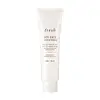What's inside
What's inside
 Key Ingredients
Key Ingredients

 Benefits
Benefits

 Concerns
Concerns

 Ingredients Side-by-side
Ingredients Side-by-side

Water
Skin ConditioningSodium C14-16 Olefin Sulfonate
CleansingMagnesium Aluminum Silicate
AbsorbentSodium Cocoamphoacetate
CleansingCetearyl Alcohol
EmollientGlyceryl Stearate
EmollientGlycerin
HumectantCharcoal Powder
AbrasivePropanediol
SolventKaolin
AbrasiveCarbon
Eucalyptus Globulus Leaf Powder
AbrasiveMentha Piperita Oil
MaskingGlycyrrhiza Glabra Root Extract
BleachingNigella Sativa Seed Extract
PerfumingEthylhexylglycerin
Skin ConditioningSodium Chloride
MaskingGlyceryl Polyacrylate
Cocamidopropyl Hydroxysultaine
CleansingXanthan Gum
EmulsifyingCaprylyl Glycol
EmollientLactic Acid
BufferingGlycolic Acid
BufferingParfum
MaskingLinalool
PerfumingBenzyl Benzoate
AntimicrobialPhenoxyethanol
PreservativeCI 77891
Cosmetic ColorantWater, Sodium C14-16 Olefin Sulfonate, Magnesium Aluminum Silicate, Sodium Cocoamphoacetate, Cetearyl Alcohol, Glyceryl Stearate, Glycerin, Charcoal Powder, Propanediol, Kaolin, Carbon, Eucalyptus Globulus Leaf Powder, Mentha Piperita Oil, Glycyrrhiza Glabra Root Extract, Nigella Sativa Seed Extract, Ethylhexylglycerin, Sodium Chloride, Glyceryl Polyacrylate, Cocamidopropyl Hydroxysultaine, Xanthan Gum, Caprylyl Glycol, Lactic Acid, Glycolic Acid, Parfum, Linalool, Benzyl Benzoate, Phenoxyethanol, CI 77891
Water
Skin ConditioningCoco-Glucoside
CleansingButylene Glycol
HumectantGlycerin
HumectantPropanediol
SolventXanthan Gum
Emulsifying1,2-Hexanediol
Skin ConditioningPolyglyceryl-10 Laurate
Skin ConditioningCentaurea Cyanus Flower Water
Skin ConditioningCucumis Sativus Fruit Extract
EmollientHelianthus Annuus Seed Oil
EmollientBorago Officinalis Seed Oil
EmollientHydrolyzed Soy Protein
HumectantRosa Damascena Extract
MaskingRosa Damascena Flower Water
MaskingAloe Barbadensis Leaf Juice
Skin ConditioningPanax Ginseng Root Extract
EmollientMalva Sylvestris Flower Extract
Skin ConditioningRosa Damascena Flower Oil
MaskingTocopherol
AntioxidantCaprylic/Capric Triglyceride
MaskingCaprylyl Glycol
EmollientHydrolyzed Jojoba Esters
Skin ConditioningSilica
AbrasiveCitric Acid
BufferingPentylene Glycol
Skin ConditioningCaramel
Cosmetic ColorantSodium Hydroxide
BufferingSodium Benzoate
MaskingPotassium Sorbate
PreservativeWater, Coco-Glucoside, Butylene Glycol, Glycerin, Propanediol, Xanthan Gum, 1,2-Hexanediol, Polyglyceryl-10 Laurate, Centaurea Cyanus Flower Water, Cucumis Sativus Fruit Extract, Helianthus Annuus Seed Oil, Borago Officinalis Seed Oil, Hydrolyzed Soy Protein, Rosa Damascena Extract, Rosa Damascena Flower Water, Aloe Barbadensis Leaf Juice, Panax Ginseng Root Extract, Malva Sylvestris Flower Extract, Rosa Damascena Flower Oil, Tocopherol, Caprylic/Capric Triglyceride, Caprylyl Glycol, Hydrolyzed Jojoba Esters, Silica, Citric Acid, Pentylene Glycol, Caramel, Sodium Hydroxide, Sodium Benzoate, Potassium Sorbate
 Reviews
Reviews

Ingredients Explained
These ingredients are found in both products.
Ingredients higher up in an ingredient list are typically present in a larger amount.
Caprylyl Glycol is a humectant and emollient, meaning it attracts and preserves moisture.
It is a common ingredient in many products, especially those designed to hydrate skin. The primary benefits are retaining moisture, skin softening, and promoting a healthy skin barrier.
Though Caprylyl Glycol is an alcohol derived from fatty acids, it is not the kind that can dry out skin.
This ingredient is also used as a preservative to extend the life of products. It has slight antimicrobial properties.
Learn more about Caprylyl GlycolGlycerin is already naturally found in your skin. It helps moisturize and protect your skin.
A study from 2016 found glycerin to be more effective as a humectant than AHAs and hyaluronic acid.
As a humectant, it helps the skin stay hydrated by pulling moisture to your skin. The low molecular weight of glycerin allows it to pull moisture into the deeper layers of your skin.
Hydrated skin improves your skin barrier; Your skin barrier helps protect against irritants and bacteria.
Glycerin has also been found to have antimicrobial and antiviral properties. Due to these properties, glycerin is often used in wound and burn treatments.
In cosmetics, glycerin is usually derived from plants such as soybean or palm. However, it can also be sourced from animals, such as tallow or animal fat.
This ingredient is organic, colorless, odorless, and non-toxic.
Glycerin is the name for this ingredient in American English. British English uses Glycerol/Glycerine.
Learn more about GlycerinPropanediol is an all-star ingredient. It softens, hydrates, and smooths the skin.
It’s often used to:
Propanediol is not likely to cause sensitivity and considered safe to use. It is derived from corn or petroleum with a clear color and no scent.
Learn more about PropanediolWater. It's the most common cosmetic ingredient of all. You'll usually see it at the top of ingredient lists, meaning that it makes up the largest part of the product.
So why is it so popular? Water most often acts as a solvent - this means that it helps dissolve other ingredients into the formulation.
You'll also recognize water as that liquid we all need to stay alive. If you see this, drink a glass of water. Stay hydrated!
Learn more about WaterXanthan gum is used as a stabilizer and thickener within cosmetic products. It helps give products a sticky, thick feeling - preventing them from being too runny.
On the technical side of things, xanthan gum is a polysaccharide - a combination consisting of multiple sugar molecules bonded together.
Xanthan gum is a pretty common and great ingredient. It is a natural, non-toxic, non-irritating ingredient that is also commonly used in food products.
Learn more about Xanthan Gum